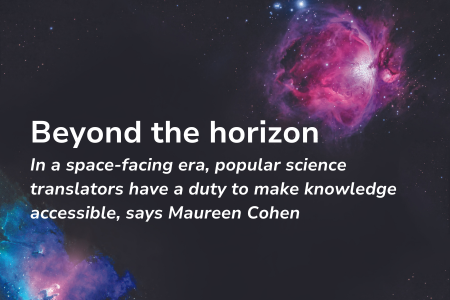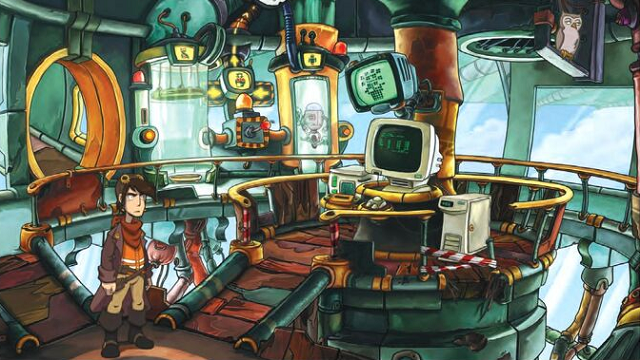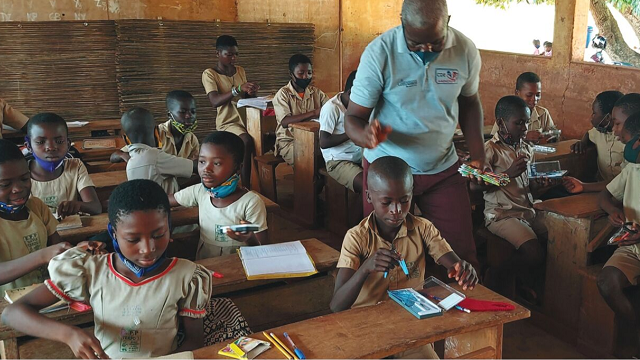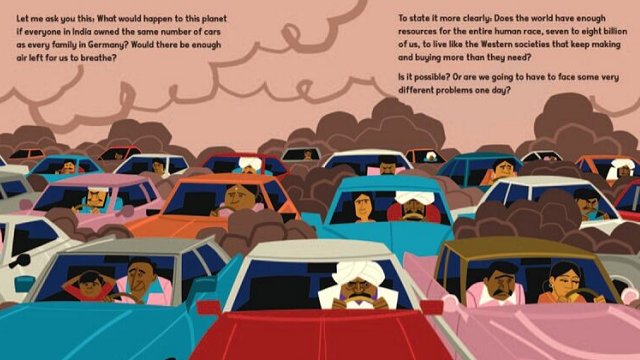-
QUALIFICATIONS
- For Linguists Worldwide
- For UK Public Services
- Preparation
- Policies & Regulation
-
MEMBERSHIP
- Join CIOL
- Membership grades
- NEW for Language Lovers
- Chartered Linguist
- Already a member?
- Professional conduct
- Business & Corporate Partners
-
ASSESSMENTS
- For Second Language Speakers
- English as a Second Language
-
TRAINING & EVENTS
- CIOL Conference Season 2025
- CPD, Webinars & Training
-
NEWS & VOICES
- News & Voices
- CIOL eNews
- CIOL Awards
- The Linguist
- Jobs & Ads
-
RESOURCES
- For Translators & Interpreters
- For Universities & Students
- Standards & Norms
- CIOL & AI
- All Party Parliamentary Group
- In the UK
- UK Public Services
- Find-a-Linguist
Beyond the horizon
By Maureen Cohen

Translators of popular science are, in a sense, translating a translation...
Scientists speak a dialect of their own, with both terminology specific to their field of inquiry and a broader idiom shared by the community as a whole. Science communicators approach their subject matter with many of the same basic problems as translators: How can I ensure the audience of my popular science article understands the content the same way a scientist understands the content of a peer-reviewed paper? How do I account for cultural differences in the meaning of fundamental concepts, like what knowledge is, what it means to be authoritative or how criticism is expressed? Where do I position my text on the spectrum ranging from accessible-but-fluffy to faithful-but-incomprehensible?
My PhD training as a planetary scientist included workshops on media, science communication and outreach as a mandatory part of the degree. As STEM fields take up ever more cultural space and our society moves towards data-driven decision making, academic scientists feel a stronger ethical imperative to communicate the meaning of their research to the public.
As a freelance translator of over 15 years, the training echoed problems and solutions of communication I had already encountered in my career. Untranslatable jargon must be avoided at all costs and replaced with glosses that convey the essential meaning. Science communicators must be aware of ‘false friends’ – phrases heard differently by the general public than by specialists. As an example, in general parlance ‘positive feedback’ implies a job well done, but in climate science, it means an increase in an environmental quantity that leads to a further increase, indefinitely – a dangerous, runaway process.
Beyond the textual level, science communication raises deeper issues of framing and emotional valence. Should climate scientists use fear-based messaging to talk about climate change? Should an exoplanet scientist mention a ‘one-sigma detection’ (indicating very low certainty) of a ‘potential biosignature’ (which could also have non-biological origins) in a press release for an upcoming paper? The way scientists talk to each other differs from how science communicators talk to the public because the scientific community has a shared context for interpreting information.
Responsible communication
I wrestled with these issues directly when writing articles for my blog and press releases for my own published papers, as I did when translating recent press releases about scientific research put out by German-language universities. My work on the atmospheric fluid dynamics of tidally locked exoplanets isn’t likely to draw interest from the broader public – but I could spice it up by contextualising it as part of the search for life on other worlds. (A draft of that article remains half-written on my laptop.)
As for my German source texts, they were responsibly written but ran into some of the problems of communication I’d encountered in my training sessions. I recall a press release reporting on a large study of the effect of ivermectin on the disease course of Covid. The article headline stated that ivermectin reduces the duration of the disease. Further down in the body of the article, the text gave the size of the effect: very small, found only in a sub-group of patients without severe disease and with low statistical significance.
I dutifully rendered the text into English, but I would have framed it quite differently were I the original author. (On searching for the study while writing this article, I found that it has been retracted, and the German and English press releases no longer exist on the university’s website.)
Cool meanings
As an example of how problems of science communication and translation can overlap, let’s look at a press release about the results of a telescope survey of M-class stars. Astronomers classify stars by their size and brightness, which are related: larger stars glow brighter (and burn out more quickly as they exhaust their fuel), while cooler stars have lower luminosities (and lifetimes spanning hundreds of billions of years). The survey, called CARMENES,1 was searching for rocky temperate planets orbiting M stars – the coolest stellar class – known colloquially as red dwarfs.
Rocky planets, like Earth and the inner planets of our solar system, usually consist of a metal core, a rocky mantle and a thin atmosphere. ‘Temperate’ means the planet is the right distance from the star to be warm enough for water to exist in liquid form and not entirely evaporate away into vapour. M-class stars are considered ideal candidates for discoveries of these kinds of planet for several reasons (there are a lot of them and they are cooler than the Sun, so any temperate planets would have to be orbiting very close, making them easier to detect).
The CARMENES team published a peer-reviewed paper in 2022 with the first findings. It refers to ‘cool stars’, which the German-language press release from the University of Heidelberg called kühle Sterne. The English translation of the press release, on the other hand, uses the phrase ‘nearby stars that are relatively “cool”‘, cuing readers that the word ‘cool’ does not have its everyday meaning – these stars are still around 3,000 Kelvin or 2,700 degrees Celsius!
The translation thereby injects context which was absent in the source, translating both the German and the science. In fact, the meaning of the terms ‘cool’ and ‘hot’ varies depending on the sub-field of astronomy or planetary science. A ‘hot Jupiter’ is much cooler than a ‘cool star’, while a ‘cool sub-Neptune’ is much hotter than a ‘warm’ rocky planet.
While the English text translates the terminology with a more sensitive ear for the target audience, both press releases communicate only part of the science. They report that the survey discovered 59 new exoplanets, but they do not explain that it estimates a planet occurrence rate of 1.24 to 1.64 planets per star. Given the abundance of M-class stars, this points towards a vast number of exoplanets in our galaxy – hundreds of billions.
A new Golden Age
While we may never explore or even observe all these worlds, the space sciences are expanding rapidly. The James Webb Space Telescope has ushered in a golden age of exoplanet science, and will soon be followed by other purpose-built observatories such as the Roman Space Telescope and the Habitable Worlds Observatory. Space enthusiasts can look forward to a constant stream of discoveries for the rest of their lives, including claims and rejections of signs of life on other planets.
But this new golden age of space science is not limited to the public sector: the commercial space industry is booming. Telecommunications and Earth observation satellites are becoming a routine part of the information economy. New space ports to launch them are springing up, including in Sutherland and Cornwall in the UK. Space tourism is a growing luxury business, with cruises to the Moon already planned by companies like Space Adventures (at a price of $150 million per seat) and dearMoon.
On the more distant horizon, private companies have ambitions to launch their own space explorations: RocketLab has announced the first private mission to Venus for 2025, and a number of companies are developing asteroid mining technologies.
All these activities, internationally networked and funded as they are, require multilingual communications. In the coming decades, it may well become possible to specialise as a space translator, blending linguistic, cultural and scientific expertise to offer the skills required for a global space-facing civilisation.
Notes
1 Calar Alto high-Resolution search for M dwarfs with Exoearths with Near-infrared and optical Echelle Spectrograph; carmenes.caha.es
Maureen Cohen MCIL has freelanced as a German-to-English translator for over 15 years and has been a Chartered Linguist since 2015. In the same year, she returned to university to obtain a physics degree and continued to earn a PhD in exoplanet science. She now works as a postdoctoral researcher in planetary science, while continuing to freelance on the side.
This article is reproduced from the Winter 2023 issue of The Linguist. Download the full edition here.
More
The Chartered Institute of Linguists (CIOL), Incorporated by Royal Charter, Registered in England and Wales Number RC 000808 and the IoL Educational Trust (IoLET), trading as CIOL Qualifications, Company limited by Guarantee, Registered in England and Wales Number 04297497 and Registered Charity Number 1090263.








